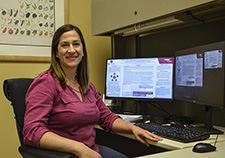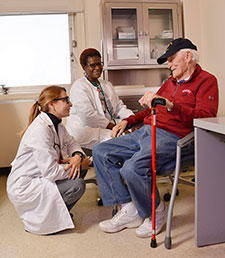Office of Research & Development |
 |


VA’s GeriPACT clinics are designed specifically to provide primary care to older Veterans. (Photo for illustrative purposes only. ©iStock/FatCamera)
February 5, 2019
By Mike Richman
VA Research Communications
The median age of the approximately 20 million Veterans who are alive today is 64, with those who fought in Vietnam, Korea, and World War II on the north side of that age demographic. Members of this cohort are often faced with multiple chronic ailments and declining mental and physical abilities.
VA has recognized that these Veterans and other former service members with geriatric health issues could benefit from a team-based, multi-disciplinary approach to medical care. Dozens of VA medical centers have thus formed Geriatric Patient Aligned Care Teams (GeriPACTs) at their respective sites. GeriPACTs are essentially primary care teams that serve older patients with complex health care needs.
GeriPACTs are like a one-stop shop. They combine traditional health care services with community-based services, featuring doctors, nurses, pharmacists, social workers, and other specialists. The goal is to streamline the health care experience of Veterans with geriatric needs and expedite their visits to a VA facility, rather than requiring them to set up multiple appointments with providers.
Watch this 2015 VHA video for a close-up look at a GeriPACT in action
The GeriPACT is a spinoff of VA’s PACT model. PACT providers treat Veterans of all ages in a team-based setting but aren’t required to have expertise in geriatric health issues.
In two VA studies, researchers assessed the impact of the GeriPACT program by surveying staff members at the 71 VA medical centers with GeriPACTs. Officials at 44 of the sites responded, within which there were a total of 101 GeriPACT teams. Many of the facilities had multiple GeriPACTs.
In one of the studies, published in the May-June 2018 issue of the Journal of the American Board of Family Medicine, researchers found that GeriPACTs are “providing services above and beyond standard PACT care. Most notable among these were practices that would be expected of programs devoted to preserving the function, autonomy, and ability to age for frail elders.”
The researchers write: “GeriPACT is one approach for bringing an interdisciplinary, patient-centered perspective to primary care in a manner that can likely [justify] the higher staffing costs,” with diminished reliance on placing people in long-term care institutions. “It is a model which can provide training for the next generation of providers and clinicians.”
GeriPACTs are like a one-stop shop.
In the other study, published in August 2018 in the journal Geriatrics, VA investigators observed a large variation in GeriPACT structure and adherence to VA guidelines—for example, those dictating how the units should be staffed. The researchers noted that GeriPACTs were characterized by a range of staffing, clinic space, and patient assignment practices.
“For example, GeriPACTs recruited patients in different ways, and not all programs had patient educators and care managers to assist with coordination with other services or had collaborative agreements in place with a PACT,” the researchers write. “More research is needed to understand how these variations are related to processes and outcomes of care.” A collaborative agreement between a GeriPACT and a PACT, for example, may call for patients who are at least 80 years old or have geriatric conditions to be seen by the facility’s GeriPACT team.

VA ear surgeon studies management of severe hearing loss in Veterans

Veteran disability payments led to fewer hospitalizations

Air Force Veteran among 10 new awardees in VA diversity, equity, and inclusion research program

VA researcher leads project to evaluate Veteran screening for malnutrition
Dr. Jennifer Sullivan of the VA Boston Healthcare System led both studies. She and her colleagues were not surprised by the structural variation of the GeriPACTs. Regarding the core GeriPACT members, 37 of the 44 sites had a social worker, 33 had a registered nurse, 32 had a doctor or geriatrician, 25 had a clerical associate, 24 had a licensed practical nurse, and 23 had a pharmacist or clinical pharmacist specialist.
“The GeriPACT model was developed and advocated for at the national level,” says Sullivan, who is also a research assistant professor at Boston University. “However, its implementation has been led locally by staff at the medical-center level. Additionally, GeriPACT implementation is influenced by local factors like a history of having geriatric programs, geriatrics-trained staff, and strong support for GeriPACT care provision, including support for clinical space and hiring extra staff as needed. These factors influence GeriPACT implementation and variation in the way the teams and care are structured.”
Sullivan points out, for example, that instead of having one full-time social worker per team, GeriPACTs cited in the study often shared a social worker if a facility had more than one GeriPACT, or the social worker was shared across GeriPACT and PACT teams due to staffing shortages. These shortages often fall outside the control of the GeriPACT leader when GeriPACT teams intersect with other hospital services that may control hiring processes, such as social work or nursing.
In addition, only 6 percent of the 44 VA medical centers followed all guidelines from the VA handbook on the implementation of GeriPACTs. There were two notable areas where more resources may be needed to help meet those inconsistencies: GeriPACT staff and dedicated space to run the clinic.
“Often times, staffing a GeriPACT team at the appropriate levels can be difficult because of turnover,” the researchers write. “In addition, there is a national shortage of providers trained in geriatrics. Furthermore, medical centers may lack resources [i.e., budget] to hire enough staff to cover more than one GeriPACT team at a facility. To further implement the model, more support will be required to bring in appropriate staff and space to serve older Veterans.”
The GeriPACT model is a modification of a former VA program of multi-disciplinary coordinated care known as Geriatric Primary Care (GPC). More than 60 VA facilities had GPC programs in 2007, with at least 66,000 patients receiving care that year. In 2010, when the VA Office of Patient Care Services implemented PACTs nationwide, GPC was rebranded as GeriPACT.
Compared to GPCs, GeriPACTs provide much better organization and structure to geriatric care through teams that are aimed at improving the quality of life and optimizing independence for vulnerable elderly Veterans with complex health care needs.
“GeriPACT has formalized elements of patient case management and links to community resources and has a larger, more integrated interdisciplinary team working together,” Sullivan says. “In the past, GPC teams may have had a smaller staff, resulting in a greater investment in time to link up with other staff like social workers and clinicians to secure services and assessments for a patient. Also, patients may not have been transferred to a GPC team to be followed for all care needs, although that would have varied per facility.”
“Some GPCs could have been rebranded GeriPACTs with few changes in the way care was structured,” she adds. “But other GPCs have reorganized to provide more coordinated care management and integrated linkages to VA and community resources through their GeriPACT clinic. Additionally, some medical centers did not have an existing GPC and started a new GeriPACT without previous GPC experience.”
In 2015, about 60,000 patients received GeriPACT services, out of the 1.5 million Veterans at least 65 years in age who were enrolled in the VA system.
In comparison to a standard PACT, three characteristics differentiate a GeriPACT: team composition, patient capacity, and provider experience.
In the study published in the Journal of the American Board of Family Medicine, researchers wrote that based on survey data from the VA facilities with GeriPACTS, “Standard PACT practices may at times be a poor fit for GeriPACTs and the populations they serve. In keeping with their advanced age, medical complexity, and high use of health services, virtually all GeriPACT patients could be identified as 'high risk’ patients by using standard metrics. In contrast, a PACT panel is more apt to be comprised of a wider range of clinical presentations, ranging from younger, healthy patients in the workforce to the frail elderly.”
Dr. Rina Eisenstein, a co-author of the study in the Journal of the American Board of Family Medicine, is a primary care doctor who specializes in geriatric medicine at the Atlanta VA Medical Center. She points out that one of the main differences between a GeriPACT and a PACT is that GeriPACT teams have a lot more time to see their patients.
“I believe we do a lot more care coordination than many PACTs do,” she says. “That means we try to coordinate people’s appointments on the same day because of possible transportation difficulties. We are staffed by fully trained and board-certified geriatric doctors, meaning they’ll go through an extra year or two or three of specific geriatric training. They look at people who have geriatric syndromes, the most notable of which are depression, dementia, functional decline, urinary incontinence, and chronic pain. In addition to providing regular primary care, we evaluate and manage geriatric conditions.”
If a patient is no longer able to travel, Eisenstein notes, that person is assigned to a home-based primary care program. Those services are normally provided by an agency that VA contracts with.
In addition to the elderly, GeriPACTs treat younger patients with geriatric-type needs. Eisenstein says one of her patients at the Atlanta VA, for example, is a 59-year-old Veteran with early-onset Alzheimer’s disease. “These types of patients are no way geriatric age, but they are geriatric-appropriate because of their inability to function,” she says.
With the Veteran population not getting any younger, Eisenstein hopes GeriPACTs will eventually be in place at all VA medical centers.
“We have a lot of Vietnam War Veterans who are getting older and had possible exposure to Agent Orange," Eisenstein says, pointing out that such exposures can lead to numerous medical problems. "Those patients are very difficult to care for, but GeriPACTs are very well-equipped to provide care for them.”
Sullivan notes that since her team’s evaluation of the GeriPACT model, new GeriPACT teams have been launched at several VA medical centers.
“In addition, some other sites have expressed interest in implementing a GeriPACT,” she says. “The future looks promising for GeriPACT implementation in the VA health care system, with continued support from VA’s central office.”

Dr. Rina Eisenstein (left) a primary care physician on the GeriPACT team at the Atlanta VA, talks with patient Henry Holley, who served in the Marines. With them is nurse care manager Cathy Woods. (Photo by Joey Rodgers)
As one who wore the uniform of the U.S. Marine Corps for 22 years, serving in World War II and the Korean War, Henry Holley subscribed to the Marines’ Latin motto: Semper fidelis—“always faithful, always loyal.”
Today, Holley is quick to apply that tag to VA. He believes the VA health care system has been incredibly faithful to him in the three years he’s been a patient of the geriatric clinic at the Atlanta VA Medical Center. The 91-year-old Veteran has serious back and knee pain stemming from his military service that inhibits his ability to walk.
“Every need I’ve had, they’re right on the spot helping me,” he says. “I just can’t get over the service and how wonderful and committed and qualified they are. They bend over backward to help me. I’m so grateful.”
Holley is one of some 1,500 patients who are enrolled in the geriatric clinic at the Atlanta VA, which formed one of the first dedicated geriatric clinics in VA. The clinic, which transitioned in 2011 to the GeriPACT Patient Aligned Care Team (GeriPACT) model, is known as the “Bronze GeriPACT.” Its patients average 86 years in age (see main story).
A review of VA GeriPACTs that appeared in the May-June 2018 issue of the Journal of the American Board of Family Medicine included a case study of the Atlanta GeriPACT. The facility has one GeriPACT team that is divided into six units. Each one includes a geriatric provider with advanced training for managing multiple illnesses in vulnerable elderly Veterans, a registered nurse care manager, a licensed professional nurse, a medical support analyst, a clinical pharmacist, a clinical psychologist, and a social worker.
In addition to informal team communication, members of the Atlanta GeriPACT huddle on a daily and weekly basis to discuss the schedule of patients. True preparation for a patient visit starts with a huddle the day before involving the primary care physician, registered nurse care manager, and licensed professional nurse.
In the huddle the day before, “Patient charts are reviewed for any recent changes in medications, specialty care encounters, hospitalizations, lab results, or missing vaccinations,” the researchers of the case study explained. “This review enables the [professional nurse] to notify the patient of lab work, logs, or other information required for [his or her] visit in a reminder call. The huddle enhances care coordination, as the team can help the patient manage multiple appointments on the same day with different members of the care team or other subspecialty clinics. Huddles are valued by team members, as they feel better prepared to anticipate the needs of the patients seen in the clinic the next day.”
Plus, the Atlanta GeriPACT adheres to the “open access” model that is required in the design of an inter-disciplinary PACT team, which see patients of all ages. That means patients are seen on a walk-in, same-day, or prescheduled basis. Every effort is made to ensure that continuity with the patient’s primary care physician is preserved.
Dr. Rina Eisenstein, a primary care doctor in the Atlanta GeriPACT, says about 80 percent of the walk-in geriatric patients are seen by their own geriatric provider. While it may be harder to be seen on a timely basis as a walk-in in a general PACT, GeriPACT providers will do everything they can to see walk-in patients as soon as they come to the clinic, she says.
“If a nurse is calling me to urgently see a [walk-in] patient, I’m going to jump out of my room in the middle of seeing another patient,” Eisenstein says. “You never know because a very sick elderly patient may appear not as sick as a younger one. Most things in geriatrics are atypical. I’ve been here for 12 years. My patients know if I must leave in the middle of a visit, something bad is going on with another Veteran. They don’t want to be in that other person’s shoes. They tell me 'go and do what you need to do. We’ll wait for you over here.’”
Continuity with the same provider is also assured by offering telephone-based care during regular clinic hours, with communication via a secure online messaging platform. The Atlanta GeriPACT also participates in an after-hours live telephone help program that is staffed by clinic nurses who provide guidance, potentially reducing emergency department use when the GeriPACT clinic is closed.
“As a result, Bronze GeriPACT matches or exceeds key performance metrics of the general PACT teams at the medical center,” the researchers write. “For example, satisfaction scores are 7 percent to 23 percent higher for GeriPACT providers than comparable PACT providers. Although GeriPACT patients are older and sicker than PACT patients, emergency department use in GeriPACT is comparable to that in PACT.”
But the Atlanta GeriPACT, the researchers note, comes up short in some areas. For one, there’s a scarcity of clerical staff, social workers, and mental health providers. Eisenstein says it all comes down to “having adequate staffing for our team,” noting that medical staff are now tasked with faxing forms and mailing letters because there are not enough clerical employees.
Space has also been a limitation, with multiple providers having to share one examination room. Atlanta VA officials are taking steps to resolve the spacing problem, according to Eisenstein.
However, the facility isn’t alone in its struggles to maintain a top-notch team that is dedicated to serving patients with geriatric needs. “Bronze GeriPACT shares challenges reflective of national variation in PACT and GeriPACT implementation,” according to the researchers on the case study.
Henry Holley would likely disagree that the Atlanta GeriPACT is deficient in any way. The GeriPACT team has provided him support in geriatric primary care, pharmacy, nursing, mental health care, and social work, and it has referred him to other departments for optical and dermatology services. The Atlanta VA has also arranged to get him a walker and a scooter, as well as a chair lift, a physical therapist, and a caregiver for use in his home.
“I even get valet parking at the Atlanta VA,” Holley says. “I try to tip the boys, but they won’t take anything.”
To show his appreciation to the Atlanta geriatric clinic, Holley has written letters to VA Secretary Robert Wilkie and Georgia Sen. Johnny Isakson, chairman of the Senate Committee on Veterans’ Affairs.
“Johnny is a good friend of mine,” says Holley, who for decades organized international crusades for the late Rev. Billy Graham. “He appreciated the letter and came by my house. He knows I’m drawing disability and am not doing well. I thought that was a very nice gesture on his part.”
--- Mike Richman
VA Research Currents archives || Sign up for VA Research updates